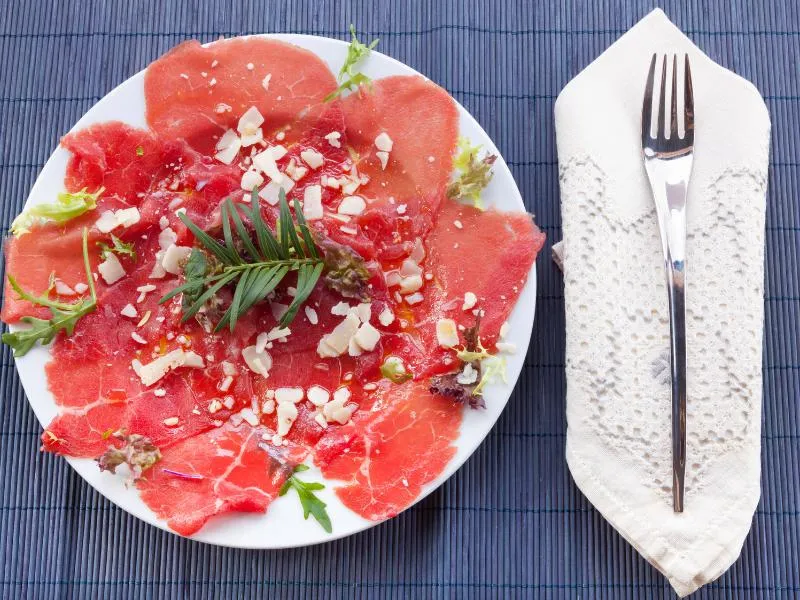Carpaccio
Paper-thin slices of raw beef dressed with olive oil, lemon, and Parmigiano-Reggiano.
👉 View Authentic Recipe 👈
About This Dish
Carpaccio is a relatively modern Italian creation, invented in 1950 by Giuseppe Cipriani, the founder of Harry’s Bar in Venice. The dish was named after the Venetian Renaissance painter Vittore Carpaccio, whose works featured vibrant red colors similar to the hue of the raw beef. Cipriani originally created it for a countess who was recommended by her doctor to eat raw meat.
Traditional Carpaccio consists of extremely thin slices of raw beef tenderloin, typically pounded to achieve paper-thin transparency. The beef is dressed simply with high-quality extra virgin olive oil, fresh lemon juice, and topped with arugula and shavings of Parmigiano-Reggiano cheese. Some versions include capers or truffle for additional flavor complexity.
While the original beef version remains the most iconic, the term “carpaccio” has evolved to describe any dish of thinly sliced raw ingredients dressed with oil and acid. Modern variations include fish carpaccio, vegetable carpaccio, and even fruit carpaccio, though purists maintain that true carpaccio should refer only to the beef preparation from Venice.
🧑🍳 Analyzed by CucinaBot
Why This Dish Works
Carpaccio exemplifies the Italian principle of highlighting exceptional ingredients with minimal intervention. The paper-thin slicing of premium beef creates a melt-in-mouth texture while maximizing surface area for the dressing. The combination of peppery arugula, acidic lemon juice, umami-rich Parmigiano-Reggiano, and fruity olive oil creates a perfect balance that “cooks” the beef slightly through acid denaturation while enhancing its natural flavors.
Key Success Factors
- Quality of Beef: Only use the freshest, highest-quality beef tenderloin from a trusted source
- Temperature Control: Partially freezing the beef (30-45 minutes) before slicing helps achieve the necessary paper-thin texture
- Slicing Technique: Cut against the grain with an extremely sharp knife for proper tenderness
- Serving Temperature: The dish must be served cold but not freezing, ideally at about 40°F (4°C)
Common Pitfalls
The most common mistake is using inferior quality beef or beef that isn’t fresh enough for raw consumption. Another frequent error is slicing the beef too thick, which compromises the delicate texture that defines authentic carpaccio. Many non-traditional recipes overpower the subtle beef flavor with excessive toppings or complicated sauces, losing the elegant simplicity that makes this dish special.
How to Judge Authenticity
When reviewing recipes, look for these markers of authenticity:
- Uses only the highest quality beef tenderloin (filetto)
- Includes a method for achieving paper-thin slices (pounding or partial freezing)
- Minimal, high-quality ingredients (olive oil, lemon, Parmigiano-Reggiano)
- Simple presentation that showcases the beef
- No cooking or heat application at any stage